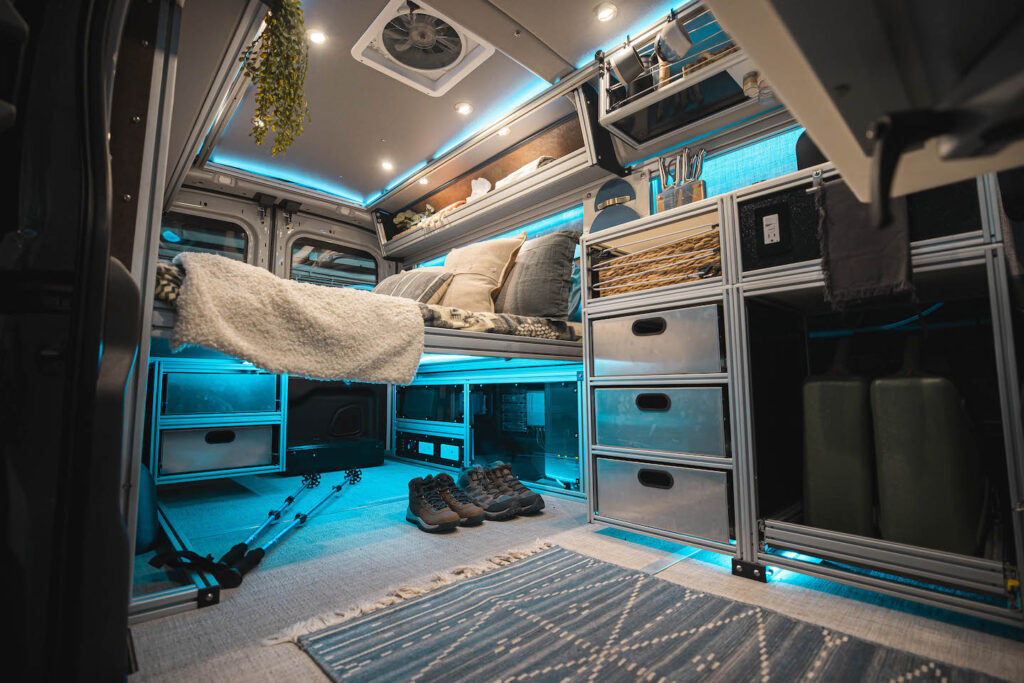Look familiar?
If you follow the work of Ford and Vandoit, you may have seen this teaser and thought, “That looks like something Vandoit would do.”
You’d be right.
Vandoit, founded by the Kline family, has a longstanding relationship with Ford that goes back multiple generations to the founding of Kline Motors in 1947 in Chillicothe, Missouri. Over the years, Vandoit and the Klines have collaborated with Ford on many projects, from marketing to design and more. So a phone call from Ford is not uncommon in the day-to-day activities at the Vandoit production facility in Blue Springs, Missouri.
But one phone call in July 2022 was a little different.
A Blind Yes
This call from Ford was to share an idea like no other. “We’re working on a new Transit package,” the Ford representative explained, “And we want an upfitter to work with.” Ford had a quick timeline–about four months. Would Vandoit be willing to build out the interior of this new vehicle in such a short time frame?
The answer was an immediate yes from Vandoit leadership. It was an opportunity to work closely with Ford and improve the products made by both companies.
But it was a bit of a blind yes: Vandoit didn’t know the precise scope of this new Transit package. The Vandoit team was going to be building on the interior of a van they had never seen before. How Ford was planning to market this new vehicle was unknown at the time. What the Vandoit team did know is that their focus would be on upfitting the interior of the van, leaving exterior components like wheels, tires, lift, and roof accessories to the Ford team.
The Ford Transit Trail
This new Ford Transit package–called the Transit Trail–is built on a cargo chassis. This presented an immediate challenge to the Vandoit engineering team, as they were used to building on the Transit passenger chassis. Vandoit had established an efficient assembly line approach to upfitting the Transit passenger chassis, so the team had to quickly adapt those processes to this new cargo version.
To launch the Transit Trail interior buildout process, the Vandoit engineering team worked closely with the Ford design team to establish production and quality parameters for the upfit. Ford also communicated their vision for the upfit: The van would contain only the driver and passenger seats in the cabin–no rear passenger seats–and have the ultimate vanlife setup for the couple who wants to wake up next to the beach and be able to prepare a gourmet breakfast from the convenience of their van. Vandoit knew immediately that their new galley and storage modules, especially the storage and counter space they create, provided the perfect solution. They also knew they could round out the ultimate van kitchen space by adding a hanging cabinet and a magnetic spice rack above the countertop. Once those parameters and vision were established, Ford gave Vandoit complete creative freedom to upfit the interior of the Trail.
Vandoit’s Goals for the Transit Trail
Very early on, the Vandoit engineering team established goals for this upfit project:
- Create the ability to sleep sideways. This is a feature often requested by current Vandoit owners, as the DO and LIV models orient the beds from front to rear, rather than side to side. The blank canvas of the Transit Trail was an ideal opportunity to create a completely new bed system, especially as the Trail does not have the rear windows the Transit passenger van has: Turning the bed sideways meant no loss of visibility.
- Create airplane-like overhead storage above the bed. The bed is always a prominent feature in any campervan, but storage solutions often require hopping out of bed or climbing underneath it. Having storage within arm’s reach of the bed is a major comfort value-add, so the engineering team created built-in cubbies above both the head and foot of the bed.
- Utilize removable kitchen modules. This goal was easy to accomplish, given that Vandoit had released these new modules only a couple of months prior to the Transit Trail project. The Vandoit engineering team selected a single sink module to go on top of a slide-out storage cabinet for water storage. This was installed between a Dometic refrigerator on one side and a single cubby/three-drawer module on the other for more kitchen storage. The modules can all be rearranged or removed altogether using simple tools.
- Expand Vandoit’s palette of materials and finishes. On the Transit Trail upfit, the engineering team hand-cut wall panels from ACM (aluminum composite material) rather than the ABS plastic panels used in the Vandoit assembly line, put in honeycomb insulation for the first time, and used new vinyl coated polyester flooring.
- Install the best power system to suit the Trail. Vandoit has installed the Mastervolt lithium power system in vans for a couple of years now, so using Mastervolt in the Trail was the obvious choice. The power system Vandoit built for the Trail is small but powerful–equivalent to the capacity of a typical AGM power system, but with the reliability of lithium technology. The marine grade components provide the durability and ruggedness needed to match the Trail’s profile.
- Make lighting practical and versatile. The Vandoit team installed interior zone lighting for the first time on the Trail upfit to accomplish two things: To use lighting to set the mood for every occasion–sleeping, stargazing, reading, relaxing by the campfire, or watching the sunrise. The zone lighting also makes it possible to turn on a light without waking a partner sleeping in bed. The new ice blue interior accent lights tied together the look and the mood.
The Upfit Process
The clock started ticking as soon as the new Transit Trail chassis pulled into the Vandoit facility in Blue Springs. The Vandoit engineering team laid eyes on the Trail for the first time and immediately assessed the cargo chassis. They needed to take quick inventory of the design changes that would need to be made from the usual Vandoit passenger chassis upfit.
The next step was a familiar one: Gut the van. The Vandoit team removed factory headliners, panels, and a few other Ford parts to make way for the new honeycomb insulation, electrical wiring, and flooring.
Next, the Vandoit engineering team worked from the back of the van to the front, mocking up the upfit structure and layout for the power box, bed platform, and storage areas. The Transit Trail cargo chassis truly provided a blank canvas for the team, as the absence of air bags, rear HVAC, and seat rails meant establishing a completely new geometry for the aluminum extrusion structure. These aspects of the cargo chassis also meant there was more interior space to work with near the van’s ceiling–the perfect spot for those airplane-style storage cubbies.
When it came to the power system in particular, the Vandoit engineering team listened to the input of current Vandoit owners to better position outlets and switches than the current DO and LIV layouts. For example, an outlet was added on the front of the sink module for easy use of kitchen appliances. These changes led to a new wiring layout and power box layout during the mock up phase. The team was forced–in the best possible way–to go back to the drawing board and see what they could do better.
As the new power system was being built, the Vandoit design team also began manufacturing the wall panels one by one. Most were hand-cut to fit the new Trail geometry, and plenty of fitment testing went into the process to get the panels just right. The final product was both practical for storage and aesthetically pleasing.
Since the bed was a main focus of the upfit, the Trail’s bed platform was a completely different design from the current LIV and DO bed systems. The Trail’s bed is essentially static; however, it can be shifted up and and down using tools to lock in at a specific height. It was important to create a full size bed that would sleep two comfortably, and as mentioned before–finally fulfill the often-voiced desire to sleep sideways. And the storage space the bed creates underneath is crucial to any van lifer for carrying supplies and outdoor gear. The addition of one of Vandoit’s three-drawer storage modules at the rear of that storage space completed the area’s utility.
As the team built each component and area of the van’s interior, they did so with careful consideration of how well the build could be replicated. The Vandoit engineering team did not view the Transit Trail interior upfit as a one-off build; rather it is a new blueprint designed to be replicated and offered again in the future.*
Approaching the Deadline
As the deadline to complete the Transit Trail’s interior upfit approached, the Vandoit team spent many late nights at the shop, putting heads together and hands on components to figure out how to finish everything to meet–and exceed–Ford’s expectations. In the final days of the upfit, two to three team members were constantly working on the van’s interior at any given time. With any spare time they found, the team made what changes they could to improve the build.
The day before the deadline, the engineering team made the final touches to the upfit, and then the Vandoit marketing team stocked the van with bedding, kitchen supplies, and decorations. The fully upfitted Transit Trail interior was ready to present to Ford.
The next day, representatives from Ford and VaynerMedia came to the Vandoit factory for a showcase of the completed Transit Trail interior. Afterwards, the Vandoit team joined Ford and VaynerMedia on set for the video shoot of the Transit Trail teaser video. Finally, the Trail was loaded onto a transport truck and headed to Detroit for additional marketing and its product release in early November.
Vandoit & Ford: Synergy & Acceleration
The outcome of this collaboration between Vandoit and Ford was a lot of synergy and an acceleration of product development for both companies. “The Transit Trail offers a lot of new features to the already proven Transit line of commercial and passenger vehicles”,” Vandoit CEO Jared McCauslin says. “Vandoit was forced to take on a lot of new challenges and obstacles. We ventured into product development scopes our company hasn’t been to in a long time. We are using our current knowledge to make our product better and broaden our horizons.” Likewise, the upfit Vandoit created in the Transit Trail gave Ford a new vision for what the Transit product can be.
*At the time of publication of this article, Vandoit does not offer the Ford Transit Trail as one of its upfit options. Vandoit does have Transit Trails on order and plans to do production runs of this new upfit. However, the timeline of this offering is yet to be determined.

